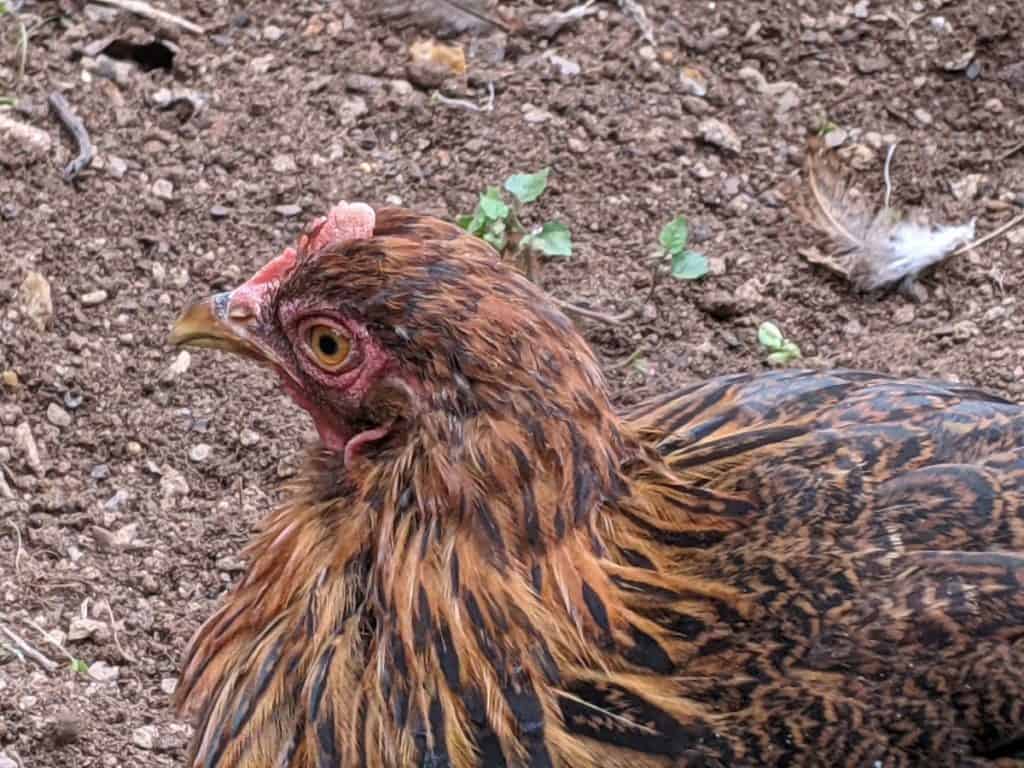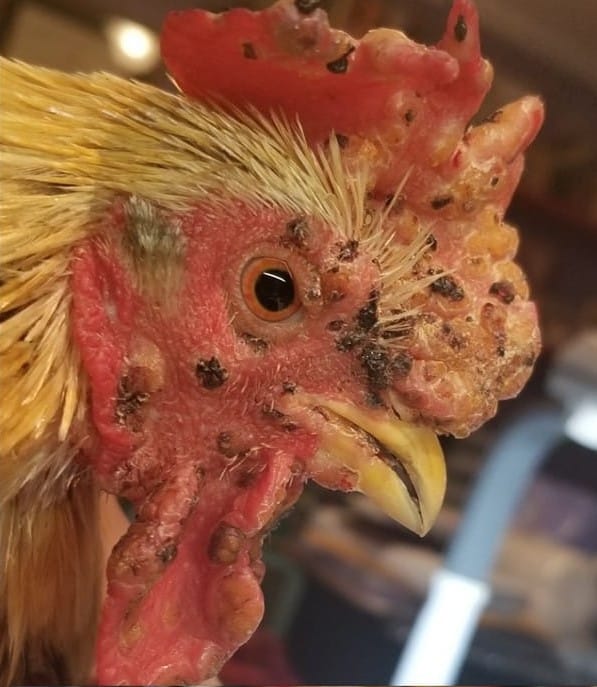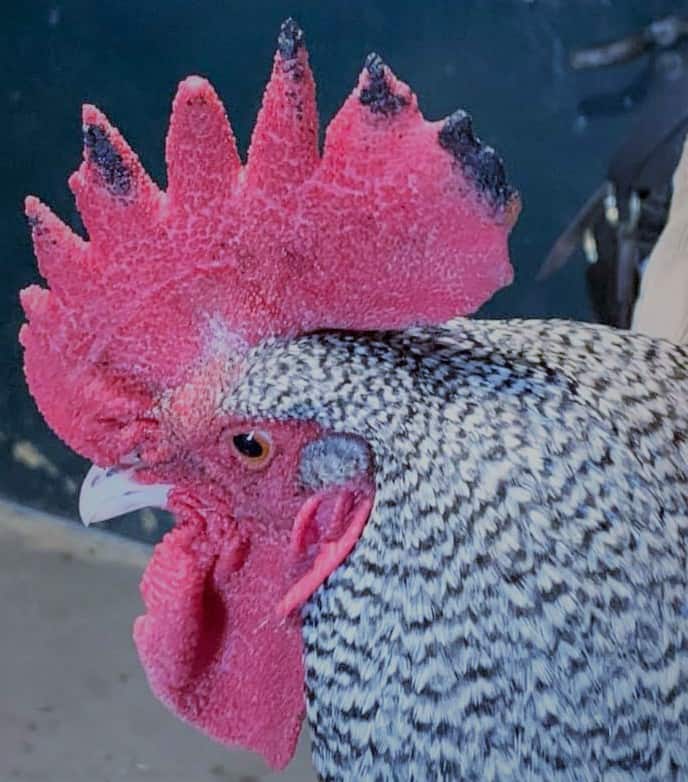A comb certainly gives a chicken a lot of character! Chicken combs are very useful to pay attention to if you are the flock’s caretaker. A backyard chicken’s health can often be determined by looking at its comb.
Changes in a chicken’s comb, such as a swollen comb or an unusually pale or dark comb, are signs of a health issue that need looking into.
Chicken comb problems include pale combs from anemia, internal worms, and heat exhaustion. White spots indicate fungus or dryness, whereas black combs signal poor circulation, frostbite, or heart and liver problems. Diseases including Avian influenza, fowl pox, and cholera also cause comb problems.
A part of raising chickens is understanding how to recognize common comb problems to treat them better. Today, we will discuss the ins and outs of chicken comb problems.
Let’s get started!

What Does a Healthy Chicken Comb Look Like?
A chicken comb consists of soft collagen tissue and usually stands upon the chicken’s head. The comb is an external indicator of a chicken’s health. The comb indicates the overall condition and, most importantly, its blood circulation. A healthy chicken typically has a vibrant, bright, rosy red comb that is firm to the touch.
By keeping an eye on your chickens’ combs, you can often be alerted to internal issues going on.

Chicken Comb Problems
Each breed has different types of combs, and each chicken’s comb looks different from the next, so keeping an eye out for changes in color and comb condition is the best way to determine what’s normal and what’s not.
Why is my Chicken’s Comb Pale?
Various reasons can cause your chicken’s comb to be pale in color.
If your chicken typically has a rosy comb that suddenly turns pink, it could indicate that it is suffering from anemia. Anemia in chickens is often caused by fleas, mites, or lice. Carefully clean the chicken coop and dust the chickens to treat them from common pests.
A pale comb can also indicate internal worms in the chicken, especially when accompanied by watery droppings and decreased egg production.
A pale comb can also signal heat exhaustion. So keep an eye out for pale combs on scorching days and provide lots of cool water and shade.
Nonetheless, non-laying chickens that aren’t fully developed also tend to have pale combs. Furthermore, if it’s molting season, there is no need to panic. Chicken combs tend to turn pale pink during molting season. Regardless, the comb should return to its vibrant red color.
To boot, when a chicken lays an egg, her blood draws to her vent, resulting in a pale comb. However, the comb immediately turns red again once the egg is laid.
White Spots on Chicken Combs
White spots usually indicate a slight fungal infection or a dry area. Dab the spotted area with some apple cider vinegar to treat the fungal infection, later apply coconut oil to further prevent the site from drying out.
Why has My Chicken’s Combs Turned Black?
A purplish or black comb can signal a lack of oxygen, poor circulation, or respiratory issues in the chicken. In extreme cases, a black comb can indicate a stroke or heart attack.
A black comb can be an indicator that your chicken has suffered from frostbite. Chickens are generally hardy birds that can tolerate cold temperatures. But unfortunately, they are prone to frostbite on their combs and wattles in extreme cold, especially when simultaneously exposed to cold and humidity.
Black spots may indicate heart and liver problems. One of the first symptoms of a chicken’s heart and liver problems is its comb turning black.
Black spots on their combs can also be scabs from being pecked at by others in the flock.
What does a swollen red Chicken Comb Mean?
When we first got our no-crow collar I noticed that our roosters’ comb had swollen and turned bright red. Turns out he was in respiratory distress and unable to breathe. I noticed this happened again when one of my hens was choking as well.
If you see a swollen comb check your chicken’s breathing.
Diseases that Lead to Chicken Comb Problems
Discoloration or black spots in a chicken’s comb can be a symptom of a health condition or a disease that the chicken might have. Here are the most common chicken diseases that can affect your chicken’s comb:
- Avian Influenza: Avian influenza is generally nonfatal. However, if your chicken is infected with a deadly strain of bird influenza, it will have symptoms including face swelling, dehydration, respiratory problems, and a black comb and wattles. They will also have blood discharged from their nostrils, and they lay soft or shell-less eggs.
- Fowlpox: Fowlpox is a highly contagious virus that causes white spots and wart-like bumps or nodules, which later turn into scabs on the combs, wattles, ears, and eyes of the chicken. Black scabs on the comb are the first indicator of fowl pox.
- Fowl Cholera: Fowl cholera is caused by bacteria with symptoms, including purple spots on the comb, wattle swelling, oral discharge, and coughing.

Why is My Chicken’s Comb Flopped Over?
If your chicken has an upright comb that suddenly went floppy, that may indicate that your chicken is dehydrated. This is because the comb acts as a cooling mechanism; when your chicken is dehydrated or has an electrolyte shortage, the comb flops over.
If this is the case, it is imperative to cool your chicken down. Make sure that your chickens have access to cool drinking water and shelter to get away from the heat
Even so, your hen’s comb may be floppy after laying an egg.
In addition, chickens can get floppy combs from old age. As a chicken matures, its comb gets bigger, similar to our ears and noses continually growing. The weight of the comb may cause it to flop over.
So, other than dehydration, a droopy comb isn’t anything to be concerned about.
Can Pecking Cause Comb Problems?
Pecking is a natural behavior for chickens. However, excessive pecking may damage your chicken’s comb. You may notice that small pieces of the comb have been damaged or are missing.
Remove the chickens that are bullying the other flock members to prevent further injuries from occurring.

Overview of Comb Problems and Causes
Listed below is a summary of comb problems and their causes.
| COMB APPEARANCE | PROBABLE CAUSE |
| RED & ROSY | Healthy and mature chicken |
| BRIGHT RED | Heat exhaustion and circulatory problems |
| PALE PINK | Molting, heat exhaustion, anemia, internal worms, just laid an egg |
| WHITE SPOTS | Fungus or dryness |
| BLACK SPOTS | Frostbite, scabs, fowl pox, Avian influenza, fowl cholera |
| PURPLE | Heat and liver problems, poor circulation |
| FLOPPY | Dehydration, old age, just laid an egg |
| MISSING PARTS | Pecking or bullying |
Conclusion
The chicken comb plays a significant role in its health for such a seemingly small part of a chicken’s body. Chicken combs are a great way to check your chicken’s overall health. Combs are also general indicators that your chicken has underlying issues that need looking after.
Frequently keeping an eye on your chickens’ combs will help you pinpoint health issues early enough to solve them.
I hope this article helped you better understand what chicken comb problems are.

